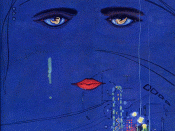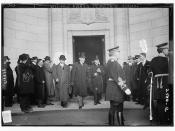Colors add spice to objects and make them look more exciting. However, besides physical appearance, colors can mean a lot when it comes representing an idea or symbol in literature. One piece of literature that demonstrates this is The Great Gatsby, by Francis Scott Fitzgerald. The plot takes place during the mid 1900's in the suburbs known as West and East Egg. Life then, like the colors of the rainbow, was vibrant and full of meaning. The author makes good use of colors to create more meaning to the book.
The color green signifies money and Gatsby's lifelong dream for Daisy. When Gatsby came back from the war, he decided to dedicate the next five years of his life to increasing his wealth for Daisy, who lived opposite of the bay from him. Five years earlier, he knew that he could not claim the love of Daisy, and so his lifelong dream is connected to money in this way.
Gatsby was in a dilemma of this life ÃÂ he either had stay with Daisy and live a poor life, or choose to make money and risk losing Daisy. In the story, Gatsby momentarily achieves both, because Daisy starts to distant herself away from her husband Tom. Another place that the color green appears is when Nick sees Gatsby reaching towards a green light at the other side of the bay. Apparently, is it Daisy who lives in the house that has that particular light. Green here represents Daisy herself, and how Gatsby has been working hard for the past five years, following her around and finally be so close to his final goal. He is also 'green' with envy when he finds out that Tom Buchanan is the man that stole his Daisy from him.
The color white, like in many other works of literature, symbolizes innocence and purity. When Gatsby and Daisy meet for the very first time in five years, it is no coincidence that Fitzgerald dressed them both up in white. Daisy thought that Gatsby had forgotten about her, so she was, so to speak, ÃÂpureÃÂ and did not think about cheating on Tom. Likewise, Gatsby thought that Daisy would easily decide to choose Gatsby over her husband in a snap, because he thought that she only ever loved him genuinely. That's why they were dressed in white for their first meeting.
Grey and blue are interlinked because they both represent Tom's life with another woman. Tom's affair is with a woman named Myrtle Wilson, who lives in what's known as the ÃÂValley of Ashes.ÃÂ This valley is a place where the absolute poor try to make a living. Almost everything is gray ÃÂ from the buildings, to George Wilson's shop...to Wilson himself, as he is covered in ashes. If one looks at the situation in a symbolic perspective, even the Wilson's' relationship is ÃÂgrayÃÂ, as Myrtle treats her husband like scum when Tom goes to meet her. Myrtle wishes she never married George, and George wishes that he could start his life all over again and not work as a car mechanic. However, amongst the boredom and the grittiness of the Valley of Ashes, there are the two orbs of blue that belong to the eyes of Dr. Eckleburg in his advertisement. The blue eyes here symbolize omniscience, or something that can see all and know all. George Wilson makes a reference to the eyes when he told Myrtle not to do anything stupid because ÃÂGod is watching everything.ÃÂ Apart from their split relationship, the Wilson's' difference of faith in God is shown particularly when Myrtle chooses to ignore her husband's warning. In the aftermath of this, she is run over and everything about the couple's lives end.
From white to gray, to blue and green, the author implements colors to help readers distinguish the mood, as well as the importance, of many major plot events. Like the colors of the rainbow, once readers look behind them to find that there is no gold, it's evident that the underlying intents and origins aren't as complicated as it all seems to be.
Knights, D., Willmott, H., & Collinson, D. (Eds.). (1985). Job Redesign: Critical Perspectives on the Labour process. England: Gower Publishing Company Limited.
Lawler, E.E. (1986). High-Involvement Management. San Francisco: Jossey-Bass Publishers, Inc.
Lawler, E.E. (1992). The Ultimate Advantage: Creating the High-Involvement Organization. San Francisco: Jossey-Bass Publishers, Inc.
Morgan, G. (1998). Images of Organization: The Executive Edition. California: Berrett-Koehler Publishers Inc. & SAGE Publications, Inc.
Robbins, S.P., Bergman, R., Stagg, I., & Coulter, M. (2003). Management (3rd ed.). Australia: Prentice Hall.
Sinclair, A. (1992). The Tyranny of a Team Ideology. Organization Studies, 13, 4, 611-626.
Vroom, V.H. (1984). Work and





